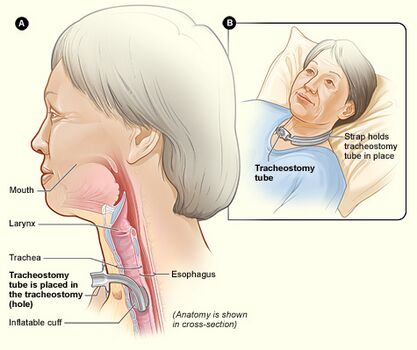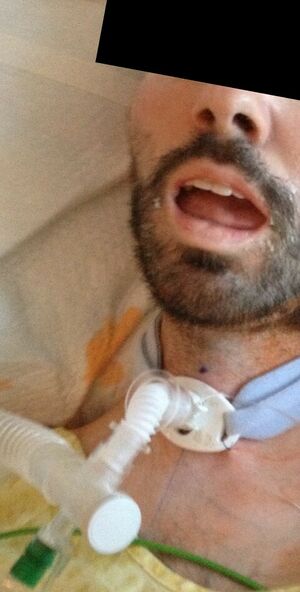Tracheostomy: Difference between revisions
No edit summary |
No edit summary |
||
| (2 intermediate revisions by the same user not shown) | |||
| Line 3: | Line 3: | ||
[[File:Tracheostomy NIH.jpeg|right|frameless|417x417px]] | [[File:Tracheostomy NIH.jpeg|right|frameless|417x417px]] | ||
A tracheostomy is a [[Surgery and General Anaesthetic|surgical]] opening in the anterior wall of the [[Trachea and Larynx|trachea]]. Traditionally a tracheostomy is performed as an open surgical procedure, however safe and reliable percutaneous tracheostomy techniques have been developed, allowing for the bedside placement of a tracheostomy in many patients<ref>Raimonde AJ, Westhoven N, Winters R. Tracheostomy.Available:https://www.ncbi.nlm.nih.gov/books/NBK559124/ (accessed 18.5.2022)</ref>. | A tracheostomy is a [[Surgery and General Anaesthetic|surgical]] opening in the anterior wall of the [[Trachea and Larynx|trachea]]. Traditionally a tracheostomy is performed as an open surgical procedure, however safe and reliable percutaneous tracheostomy techniques have been developed, allowing for the bedside placement of a tracheostomy in many patients<ref>Raimonde AJ, Westhoven N, Winters R. Tracheostomy.Available:https://www.ncbi.nlm.nih.gov/books/NBK559124/ (accessed 18.5.2022)</ref>. | ||
This 6 minute video explains what a tracheotomy is. | |||
{{#ev:youtube|ULb5q6aBuic|300}} | |||
==== '''Percutaneous Tracheostomy''' ==== | ==== '''Percutaneous Tracheostomy''' ==== | ||
A percutaneous tracheotomy (PT) is typically performed in a hospital room. The doctor makes a small incision near the base of the front of the neck. A special lens is fed through the mouth so that the surgeon can view the inside of the throat. Using this view of the throat, the surgeon guides a needle into the windpipe to create the tracheostomy hole, then expands it to the appropriate size for the tube. Bedside PT generates significant cost savings by eliminating operating room and anesthesia charges. Bronchoscopy is commonly used as a visual aid during PT. Ultrasound (US)-guided PT is gaining popularity<ref>Al-Shathri Z, Susanto I. Percutaneous tracheostomy. InSeminars in Respiratory and Critical Care Medicine 2018 Dec (Vol. 39, No. 06, pp. 720-730). Thieme Medical Publishers.Available: https://pubmed.ncbi.nlm.nih.gov/30641590/<nowiki/>(accessed 18.5.2022)</ref>. | Percutaneous Tracheostomy involves Seldinger technique and dilatation of trachea between rings<ref name=":1">Life in the fast lane Available: https://litfl.com/percutaneous-tracheostomy/ (accessed 18.5.2022)</ref>. | ||
A percutaneous tracheotomy (PT) is typically performed in a hospital room. The doctor makes a small incision near the base of the front of the neck. A special lens is fed through the mouth so that the surgeon can view the inside of the throat. Using this view of the throat, the surgeon guides a needle into the windpipe to create the tracheostomy hole, then expands it to the appropriate size for the tube<ref name=":2">Mayo clinic Tracheostomy Available: https://www.mayoclinic.org/tests-procedures/tracheostomy/about/pac-20384673<nowiki/>(accessed 18.5.2022)</ref>. Bedside PT generates significant cost savings by eliminating operating room and anesthesia charges. Bronchoscopy is commonly used as a visual aid during PT. Ultrasound (US)-guided PT is gaining popularity<ref>Al-Shathri Z, Susanto I. Percutaneous tracheostomy. InSeminars in Respiratory and Critical Care Medicine 2018 Dec (Vol. 39, No. 06, pp. 720-730). Thieme Medical Publishers.Available: https://pubmed.ncbi.nlm.nih.gov/30641590/<nowiki/>(accessed 18.5.2022)</ref>. | |||
==== '''Surgical Tracheostomy''' ==== | ==== '''Surgical Tracheostomy''' ==== | ||
[[File:Tracheostomy with tube.jpeg|thumb|Tracheostomy with tube]] | Surgical Tracheostomy involves dissection and incision of trachea under direct vision<ref name=":1" />.[[File:Tracheostomy with tube.jpeg|thumb|Tracheostomy with tube]] | ||
Surgical tracheotomy can be performed in an operating room or in a hospital room. The person is positioned on there back, and a rolled-up towel (or equivalent) is placed under your shoulders to help stretch | Surgical tracheotomy can be performed in an operating room or in a hospital room. The person is positioned on there back, and a rolled-up towel (or equivalent) is placed under your shoulders to help stretch persons neck. Local anaesthetic is injected into the target area, and a skin incision (cut) is made. The surgeon will then open either the trachea (this is called a ‘tracheostomy’) or the cricothyroid membrane - the thinnest part of the airway below the larynx (this is called a ‘cricothyroidotomy’). The airway tube is inserted into the trachea and person is connected to the oxygen supply. The entire procedure is done as quickly as possible<ref name=":2" />. | ||
== Indications for a Tracheostomy<ref name=":0">NHS e-Learning for Healthcare and the Royal College of Anaesthetists. Understanding Tracheostomies and Laryngectomies. Available at https://cs1.e-learningforhealthcare.org.uk/content/NTSP_01_001/d/ELFH_Session/_/session.html#overview.html (accessed 23 May 2020)</ref> == | == Indications for a Tracheostomy<ref name=":0">NHS e-Learning for Healthcare and the Royal College of Anaesthetists. Understanding Tracheostomies and Laryngectomies. Available at https://cs1.e-learningforhealthcare.org.uk/content/NTSP_01_001/d/ELFH_Session/_/session.html#overview.html (accessed 23 May 2020)</ref> == | ||
Latest revision as of 03:04, 18 May 2022
Introduction[edit | edit source]
A tracheostomy is a surgical opening in the anterior wall of the trachea. Traditionally a tracheostomy is performed as an open surgical procedure, however safe and reliable percutaneous tracheostomy techniques have been developed, allowing for the bedside placement of a tracheostomy in many patients[1].
This 6 minute video explains what a tracheotomy is.
Percutaneous Tracheostomy[edit | edit source]
Percutaneous Tracheostomy involves Seldinger technique and dilatation of trachea between rings[2].
A percutaneous tracheotomy (PT) is typically performed in a hospital room. The doctor makes a small incision near the base of the front of the neck. A special lens is fed through the mouth so that the surgeon can view the inside of the throat. Using this view of the throat, the surgeon guides a needle into the windpipe to create the tracheostomy hole, then expands it to the appropriate size for the tube[3]. Bedside PT generates significant cost savings by eliminating operating room and anesthesia charges. Bronchoscopy is commonly used as a visual aid during PT. Ultrasound (US)-guided PT is gaining popularity[4].
Surgical Tracheostomy[edit | edit source]
Surgical Tracheostomy involves dissection and incision of trachea under direct vision[2].
Surgical tracheotomy can be performed in an operating room or in a hospital room. The person is positioned on there back, and a rolled-up towel (or equivalent) is placed under your shoulders to help stretch persons neck. Local anaesthetic is injected into the target area, and a skin incision (cut) is made. The surgeon will then open either the trachea (this is called a ‘tracheostomy’) or the cricothyroid membrane - the thinnest part of the airway below the larynx (this is called a ‘cricothyroidotomy’). The airway tube is inserted into the trachea and person is connected to the oxygen supply. The entire procedure is done as quickly as possible[3].
Indications for a Tracheostomy[5][edit | edit source]
Airway obstruction[edit | edit source]
- To secure and clear the airway in upper respiratory tract obstruction
- An obstruction, often caused by a cancer, swelling of the airway, infection, inflammation or trauma
- Where an airway is predicted to get worse and possibly become actually obstructed E.g. after major head and neck surgery
Providing an artificial airway for ventilation[edit | edit source]
- A tracheostomy is usually well tolerated and typically does not require sedation once it has been inserted.
- It is the best way of invasively ventilating a patient in the medium to long term, it provides a secure airway without directly interfering with the larynx
- It can facilitate weaning from ventilation.
- It can enable long-term mechanical ventilation of patients, either in an acute setting or long term.
Protecting the airway[edit | edit source]
- Some patients are at high risk of aspirating secretions or gastric contents into the airway. E.g. neuromuscular disorders, head injuries, unconsciousness, stroke or following prolonged disuse such as after trans-laryngeal intubation (Endotracheal Tube)
- A tracheostomy tube with the cuff inflated reduces the risk and offers some protection against aspiration
- Sub-glottic suction systems can help to reduce secretions that enter the airway
Respiratory secretion management[edit | edit source]
- To facilitate the removal of bronchial secretions where there is poor cough effort with sputum retention
- Tracheostomy allows manual insufflation-exsufflation (cough assist) to be applied directly to the lungs
- Suction directly into the trachea to help clear secretions.[5]
Other Reasons for a Tracheostomy[6][edit | edit source]
- Neuromuscular diseases paralyzing or weakening chest muscles and diaphragm
- Aspiration related to muscle or sensory problems in the throat
- Fracture of cervical vertebrae with spinal cord injury
- Long-term unconsciousness or coma
- Disorders of respiratory control such as congenital central hypoventilation or central apnea
- Facial surgery and facial burns
- Anaphylaxis (severe allergic reaction)
Physiological Changes[edit | edit source]
- The upper airway anatomical dead space can be reduced by up to 50%. - This space takes no part in gas exchange and adds to the work of breathing. Reducing this can help patients wean off a ventilator more easily.
- The natural warming, humidification and filtering of air that usually takes place in the upper airway is lost
- The patient's ability to speak is removed/reduced as the cuff impairs the swallowing mechanisms of the larynx
- The ability to swallow is adversely affected
- Sense of taste and smell can be lost which can have a negative impact on appetite.
- Altered body image[5]
Complications[edit | edit source]
Perioperative period[edit | edit source]
- Haemorrhage
- Misplacement of tube - within tissues around trachea or to main bronchus
- Pneumothorax
- Tube occlusion
- Surgical emphysema
- Loss of the upper airway
Postoperative period < 7 days[edit | edit source]
- Tube blockage with secretions or blood
- Partial or complete tube displacement
- Infection of the stoma site
- Infection of the bronchial tree (pneumonia)
- Ulceration, and/or necrosis of trachea or mucosal ulceration by tube migration
- Risk of occlusion of the tracheostomy tube in obese or fatigued patients who have difficulty extending their neck
- Tracheo-oesophageal fistula formation
- Haemorrhage
Late postoperative period >7 days[edit | edit source]
- Granulomata (a mass of granulation tissue) of the trachea may cause respiratory difficulty when the tracheostomy tube is removed
- Tracheal dilation, stenosis or tracheomalacia (trachea partly collapses especially during increased airflow)
- Scar formation-requiring revision
- Haemorrhage
Types of Tubes[edit | edit source]
Cuffed with fenestrated tubes[edit | edit source]
Used for patients who are on the ventilator but are not able to tolerate a speaking valve to speak
Cuffed with unfenestrated tubes[edit | edit source]
Used to obtain a closed circuit for ventilation
Uncuffed with fenestrated tubes[edit | edit source]
Used for patients who have difficulty using a speaking valve
Uncuffed with unfenestrated tubes[edit | edit source]
Used for patients with tracheal problems
Used for patients who are ready for decannulation
Patient may be able to eat and may be able to talk without a speaking valve.
Resources[edit | edit source]
UK National Tracheostomy Safety Project http://www.tracheostomy.org.uk/
Watch a Tracheostomy https://www.hopkinsmedicine.org/tracheostomy/video/watching.html
References[edit | edit source]
- ↑ Raimonde AJ, Westhoven N, Winters R. Tracheostomy.Available:https://www.ncbi.nlm.nih.gov/books/NBK559124/ (accessed 18.5.2022)
- ↑ 2.0 2.1 Life in the fast lane Available: https://litfl.com/percutaneous-tracheostomy/ (accessed 18.5.2022)
- ↑ 3.0 3.1 Mayo clinic Tracheostomy Available: https://www.mayoclinic.org/tests-procedures/tracheostomy/about/pac-20384673(accessed 18.5.2022)
- ↑ Al-Shathri Z, Susanto I. Percutaneous tracheostomy. InSeminars in Respiratory and Critical Care Medicine 2018 Dec (Vol. 39, No. 06, pp. 720-730). Thieme Medical Publishers.Available: https://pubmed.ncbi.nlm.nih.gov/30641590/(accessed 18.5.2022)
- ↑ 5.0 5.1 5.2 NHS e-Learning for Healthcare and the Royal College of Anaesthetists. Understanding Tracheostomies and Laryngectomies. Available at https://cs1.e-learningforhealthcare.org.uk/content/NTSP_01_001/d/ELFH_Session/_/session.html#overview.html (accessed 23 May 2020)
- ↑ The Johns Hopkins University. Reasons for a tracheostomy. Available from https://www.hopkinsmedicine.org/tracheostomy/about/reasons.html(accessed 26 May 2020)
- ↑ National Tracheostomy Safety Project. Understanding Tracheostomy Tubes (National Tracheostomy Safety Project). Available from https://www.youtube.com/watch?v=KBbpxsznEPc (Accessed May 31st 2020)








